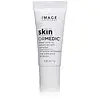What's inside
What's inside
 Key Ingredients
Key Ingredients

 Benefits
Benefits

 Concerns
Concerns

 Ingredients Side-by-side
Ingredients Side-by-side

Hydrogenated Polyisobutene
EmollientPetrolatum
EmollientEthylene/Propylene/Styrene Copolymer
Butylene/Ethylene/Styrene Copolymer
Beeswax
Emulsion StabilisingBrassica Campestris/Aleurites Fordi Oil Copolymer
Skin ConditioningTocopheryl Acetate
AntioxidantOlea Europaea Fruit Oil
MaskingGlycine Soja Oil
EmollientPrunus Amygdalus Dulcis Oil
Skin ConditioningEthylhexyl Palmitate
EmollientCeramide NP
Skin ConditioningTribehenin
EmollientPropylparaben
PreservativeSorbitan Isostearate
EmulsifyingPalmitoyl Oligopeptide
CleansingParfum
MaskingMica
Cosmetic ColorantTitanium Dioxide
Cosmetic ColorantIron Oxides
Hydrogenated Polyisobutene, Petrolatum, Ethylene/Propylene/Styrene Copolymer, Butylene/Ethylene/Styrene Copolymer, Beeswax, Brassica Campestris/Aleurites Fordi Oil Copolymer, Tocopheryl Acetate, Olea Europaea Fruit Oil, Glycine Soja Oil, Prunus Amygdalus Dulcis Oil, Ethylhexyl Palmitate, Ceramide NP, Tribehenin, Propylparaben, Sorbitan Isostearate, Palmitoyl Oligopeptide, Parfum, Mica, Titanium Dioxide, Iron Oxides
Hydrogenated Polyisobutene
EmollientEthylene/Propylene/Styrene Copolymer
Persea Gratissima Oil
Skin ConditioningPhenyl Trimethicone
Skin ConditioningPentaerythrityl Tetraisostearate
EmollientEthylhexyl Palmitate
EmollientPPG-12/Smdi Copolymer
EmollientTribehenin
EmollientButylene/Ethylene/Styrene Copolymer
Diisopropyl Dimer Dilinoleate
EmollientAroma
Tocopheryl Acetate
AntioxidantMica
Cosmetic ColorantLimonene
PerfumingCI 77891
Cosmetic ColorantSilica Dimethyl Silylate
EmollientSorbitan Isostearate
EmulsifyingButylene Glycol
HumectantPentylene Glycol
Skin ConditioningSodium Chondroitin Sulfate
Skin ConditioningPentaerythrityl Tetra-Di-T-Butyl Hydroxyhydrocinnamate
AntioxidantAtelocollagen
Skin ConditioningCaesalpinia Sappan Bark Extract
Skin ConditioningTocopherol
AntioxidantLinalool
PerfumingCitral
PerfumingTin Oxide
AbrasivePalmitoyl Tripeptide-1
Skin ConditioningOryzanol
Skin ConditioningUbiquinone
AntioxidantHydrogenated Polyisobutene, Ethylene/Propylene/Styrene Copolymer, Persea Gratissima Oil, Phenyl Trimethicone, Pentaerythrityl Tetraisostearate, Ethylhexyl Palmitate, PPG-12/Smdi Copolymer, Tribehenin, Butylene/Ethylene/Styrene Copolymer, Diisopropyl Dimer Dilinoleate, Aroma, Tocopheryl Acetate, Mica, Limonene, CI 77891, Silica Dimethyl Silylate, Sorbitan Isostearate, Butylene Glycol, Pentylene Glycol, Sodium Chondroitin Sulfate, Pentaerythrityl Tetra-Di-T-Butyl Hydroxyhydrocinnamate, Atelocollagen, Caesalpinia Sappan Bark Extract, Tocopherol, Linalool, Citral, Tin Oxide, Palmitoyl Tripeptide-1, Oryzanol, Ubiquinone
Ingredients Explained
These ingredients are found in both products.
Ingredients higher up in an ingredient list are typically present in a larger amount.
We don't have a description for Butylene/Ethylene/Styrene Copolymer yet.
We don't have a description for Ethylene/Propylene/Styrene Copolymer yet.
Ethylhexyl Palmitate, also known as octyl palmitate, is created from 2-ethylhexyl alcohol and palmitic acid. It is a fatty acid ester.
The fatty acid content of Ethylhexyl Palmitate makes it an emollient. Emollients help soften and hydrate your skin by trapping moisture within.
Ethylhexyl Palmitate is also used to help improve the texture of cosmetics. It helps other ingredient dissolve in products and help disperse ingredients more evenly.
You'll likely find this ingredient in sunscreen, as it is often used to mix UV-blocking ingredients such as avobenzone and ethylhexyl triazone.
It can also help stabilize the fragrances in a product as a fragrance fixative.
Ethylhexyl Palmitate can be used to substitute mineral oil.
Due to its high fatty acid content, it may not be fungal-acne safe.
Learn more about Ethylhexyl PalmitateHydrogenated Polyisobutene is a synthetic polymer. Polymers are compounds with high molecular weight. Hydrogenated Polyisobutene is an emollient and texture enhancer.
In one study, Hydrogenated Polyisobutene showed better skin hydration levels than Caprylic/Capric Triglyceride. As an emollient, it helps keep your skin soft and hydrated by trapping moisture in.
Hydrogenated Polyisobutene is often used as a mineral oil replacement.
Learn more about Hydrogenated PolyisobuteneMica is a naturally occurring mineral used to add shimmer and color in cosmetics. It can also help improve the texture of a product or give it an opaque, white/silver color.
Serecite is the name for very fine but ragged grains of mica.
This ingredient is often coated with metal oxides like titanium dioxide. Trace amounts of heavy metals may be found in mica, but these metals are not harmful in our personal products.
Mica has been used since prehistoric times throughout the world. Ancient Egyptian, Indian, Greek, Roman, Aztec, and Chinese civilizations have used mica.
Learn more about MicaSorbitan Isostearate is an emulsifer and cleaning agent. It is created from isostearic acid and sorbitol.
As an emulsifier, Sorbitan Isostearate prevents oils and water from separating.
Due to its isostearic acid base, it may not be safe for Malassezia or fungal acne.
Learn more about Sorbitan IsostearateTocopheryl Acetate is AKA Vitamin E. It is an antioxidant and protects your skin from free radicals. Free radicals damage the skin by breaking down collagen.
One study found using Tocopheryl Acetate with Vitamin C decreased the number of sunburned cells.
Tocopheryl Acetate is commonly found in both skincare and dietary supplements.
Learn more about Tocopheryl AcetateTribehenin comes from glycerin and behenic acid.
It is used as an emollient, or moisturizer. Emollients form a thin barrier on skin to prevent moisture from escaping.
This ingredient may not be Malassezia folliculitis, or fungal-acne safe.
Learn more about Tribehenin